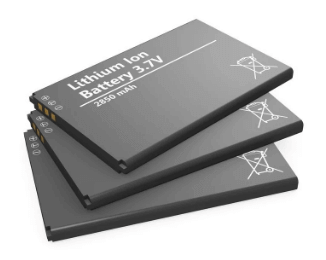



The “old” batteries in modern, mobile electrical equipment are being replaced by more powerful lithium rechargeable batteries. Cell phones, laptops, digital cameras and even portable handheld tools like cordless drills or screwdrivers – not to mention hundreds of thousands of e-bikes – that are already in use in Austria are being powered by lithium rechargeable batteries.
Whereas in the past, nickel-cadmium batteries, for example, had to be completely discharged before they could be recharged, this is no longer necessary with modern lithium rechargeable batteries. They no longer have a memory effect, which reduces the batteries’ storage capacity. Functional lithium rechargeable batteries are very safe to use, since they are protected against both harmful overcharging and deep discharge. But unlike older rechargeable battery technologies, they sometimes react to mechanical damage and to strong heat supply with what is described in technical terms as an uncontrollable “thermal runaway”, which can cause a fire to break out.
Take special care when storing and collecting the batteries. Dangerous reactions can largely be avoided by protecting batteries against heat and mechanical damage.
Only use genuine chargers and accessories where possible. Doing so prevents overcharging and short-circuits. In any case, observe the manufacturer’s operating manual and safety instructions!
Not every instance of internal mechanical damage is immediately obvious! So be sure to handle batteries carefully! A damaged lithium battery is recognizable by the likes of deformed housing, scorch marks / discoloration, heating when not in use, smoke development or a burning smell.
Do not allow the rechargeable battery contacts (outside of the equipment) to come into contact with metal objects, like coins or keys, to avoid a short-circuit.
Do not expose your cell phone or rechargeable batteries to high temperatures or moisture.
Lithium rechargeable batteries should not be collected and stored in large quantities at home. It is advisable to store them in a way that they are protected (e.g. in the original packaging) and hand them in promptly to a collection point. For larger rechargeable batteries where bare contacts are visible, be sure to mask off the terminals.
If there’s no easy way of removing the rechargeable battery from the device, the trained personnel at the municipal collection points will help you. There are special collection containers for equipment with non-removable rechargeable batteries.
Do not dispose of used (rechargeable) batteries in the residual waste! Lithium rechargeable batteries and waste electronic equipment containing such (rechargeable) batteries can be handed in at municipal collection points in Austria for free. They will then be recycled in an environmentally friendly way. You can also return (rechargeable) batteries free of charge at stores that sell them. Just drop them in the designated battery collection boxes.
